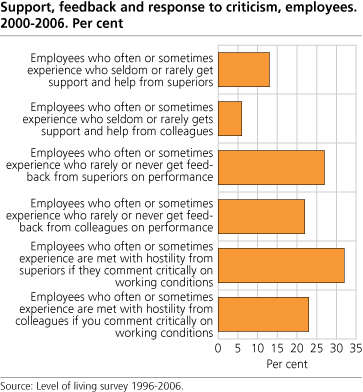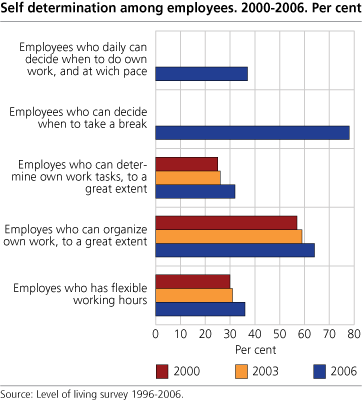Content
Published:
This is an archived release.
Lack of feedback to one out of four
Around one out of ten employees were afraid of losing their job in 2006. In 2003, the corresponding figure was two out of ten. More employees can determine important aspects of their own work, but at the same time about one out of four rarely or never get feedback from superiors.
In the 2006 level of living survey, employees were asked different questions about support and feedback in their organisation. Twenty-seven per cent said that they rarely or never got feedback from superiors on how they did their job. The age group 45-66 more often than younger employees said that they rarely or never got support or help in their work. The oldest age group also said that they didn’t get feedback on how they did their work. Nearly one out of three employees said they are met with hostility from superiors if they criticise the work conditions. Large variations in support and feedback were found among different occupations.
Fewer afraid of losing their job
Eleven per cent said they were in danger of losing their job in 2006. As many as 20 per cent stated the same in 2003. The unemployment rate was 4.6 per cent in 2003 and as low as 2.8 per cent in 2006. This may explain some of the decline. The share of employees with temporary employment has not changed. Twelve per cent were temporarily employed in 2006 and the share has been relatively stable the last ten years. Almost all employees have a written employment contract and more people have one now than ten years ago. Six per cent of all employees say that they are looking for another job.
A great deal of self determination in the work place
A large number of respondents in the survey stated that they can determine important aspects of their work. Almost four out of ten employees say they can decide when to do their own work on a daily basis, and at what pace. Two out of three employees can organise their own work, to a great extent, and almost eight out of ten can decide when to take a break. Degree of self determination increases with age, and men have more self determination than women.
Level of living survey 2006 - changesThe level of living survey will use a sample of 19,000 persons aged 16 to 66 from 2006 onwards whenever work environment is the theme. This will give researchers greater opportunities to carry out detailed analyses of the work environment in different occupational groups and industries. |
Tables:
- Table 1 Physical work environment for employees, by occupation, level 2. 2006. Per cent
- Table 2 Physical work environment for employees, by occupation, level 2. 2006. Per cent. Continuing
- Table 3 Attachment to the workplace and opportunity for development, by occupation, level 2. 2006. Per cent
- Table 4 Attachment to the workplace and opportunity for development, by occupation, level 2. 2006. Per cent. Continuing
- Table 5 Workrelated health problems and sickness absenteeism, by accupation, level 2. 2006. Per cent.
- Table 6 Workrelatet healtproblems and sickness absenteeism, by accupation, level 2. 2006. Percent. Continuing
- Table 7 Psychosocial work enviroment: help and feedback, relations, values, violence and harassment, by occupation, level 2. 2006. Percent
- Table 8 Psychosocial work enviroment: help and feedback, relations, values, violence and harassment, by occupation, level 2. 2006. Continuing
- Table 9 Psychosocial work environment: jobdemands, role conflicts, control and managing by occupation, level 2. 2006. Percent
- Table 10 Psychosocial work environment: jobdemands, role conflicts, control and managing by occupation, level 2. 2006. Percent. Continuing
- Table 11 Psychosocial work environment: jobdemands, role conflicts, control and managing, by age and sex. 2006. Per cent
- Table 12 Psychosocial work environment: jobdemands, role conflicts, control and managing by size of company. 2006. Percent.
- Table 13 Psychosocial work environment: jobdemands, role conflicts, control and managing by occupation, level 1. 2006. Percent.
- Table 14 Psychosocial work environment: jobdemands, role conflicts, control and managing by sex and occupation, level 1. Women. 2006. Percent.
- Table 15 Psychosocial work environment: jobdemands, role conflicts, control and managing by sex and occupation, level 1. Women. 2006. Percent.
- Table 16 Psychosocial work environment: jobdemands, role conflicts, control and managing by industry. 2006. Percent.
- Table 17 Psychosocial work environment: jobdemands, role conflicts, control and managing by working time arrangement. 2006. Percent.
Contact
-
Mari Lande With
E-mail: mari.lande.with@ssb.no
tel.: (+47) 98 43 36 65
-
Håvard Bergesen Dalen
E-mail: havard.dalen@ssb.no
tel.: (+47) 40 90 23 50


